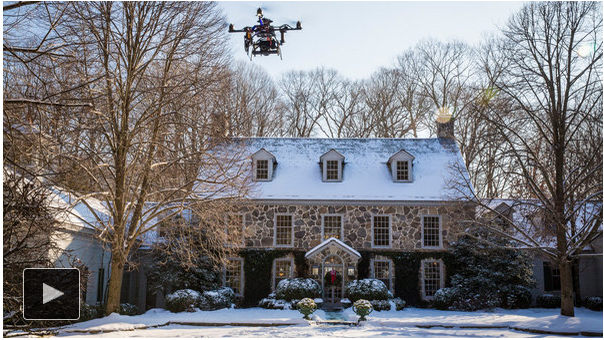Quadcopters, also called drones, have been working in the high-end real estate industry for several years ever since ready-to-fly models have become so popular and affordable.
Halstead Property is a real estate company specializing in exclusive real estate in New York, Connecticut and New Jersey. They have contracted videographer/pilots to do aerial video for over 200 exclusive homes in the tri-state area. The video above features quadcopter footage of a $7.6 million beach house in Darien, Conn. This video has been viewed more than 500,000 times.
As we point out in our previous article on the subject of quadcopter videography, the Federal Aviation Administration, does not sanction flying quadcopters outdoors for commercial purposes. See Quadcopters and The Law. Real estate agents and drone pilots say they fly the machines on private property and fly them below 400 feet, two requirements for flying non-commercial drone.
An F.A.A. spokesman said that those model airplane guidelines do not apply to commercial drones and that drone operators needed special approval from the agency. The spokesman added that no real estate agency had been granted permission. In the only such case publicly disclosed by the agency, it issued a $10,000 fine — the maximum for a violation — in 2012 to a man who was flying a drone around the University of Virginia campus; the man is appealing the fine. See FAA Takes First Legal Action Against Model Airplane Pilot.








As a video producer located in San Jose, Ca, I thought about adding aerial video to my list of services for another revenue stream. However, after reading several articles from different sources stating that video-equipped drones used for commercial purposes (i.e. selling the footage for money) is not permitted by the FAA. Even in the article above where the Real Estate agent is on private property, you are at risk for being fined. I will stand by until the FAA sobers up and gets their claws out of my business.
Great position to take [ wait to see how things develop], good thing you were not part of our Founding Fathers.
I was playing it cautious on the part of my readers. It’s a fascinating area that I find very cool, but I wouldn’t want anyone to get in serious trouble or cause injuries because of something I encouraged them to do.
Long before this hit the mainstream press several members of the VideoUniversity Forums were doing remote aerial video and posting them on the forums. One guy had done some remarkable shooting until he had an accident which involved an emergency room visit where he was lucky not to have lost a few fingers. Point is these things carry danger.
If they had the option, I’m sure the early Americans would have used unmanned drones to beat the British. I hope I would have helped. But that was the American Revolutionary War, a far cry from the use of Quadcopters for business.
People get hurt on set all the time. Doesnt stop you from talking about cranes or jibs, or how about lights falling on my head. I mean I almost got two stitches. Just write about what’s relevant. We can fend for ourselves.
You sir are 100% correct. The people who “stand by and wait to see how FAA rules” are not worth their weight in salt. They need to grow a pair. My dad was right, Lead, Follow or get the hell out of the way. Flying a quadcopter and taking video as a source of revenue is nobody’s business but mine, as long as I follow the FAA guidelines and take all precautions to fly safe.
I have to side with the FAA on this one. After viewing the video, it is clear that no safety was provided for the people on the street. What recourse would be sought after, for the actions of the UAV operator and the body of professionals who aurtherized his actions, in the event of the UAV striking a person or vehicle? I am against any “Drone” flights for commercial purpose without the requirement of liability insurance and clearing the area to be filmed of “civilian” personnel and property. A UAV operation should also require a film permit and organization of safety personnel and the securing of the area to prevent the general public from entry of the are to be filmed without consent. Taking video in the public domain is legal under the law that a person can not expect total privacy while in public. The general public is granted to expectation to safely move about without additional risk from injury by a UAV. A UAV operator does not follow the rules of the road during operation of the UAV. Thus the FAA must preside over the operations of a UAV and hold the UAV operator liable for their actions and potential accidents. The film industry takes extreme measures to ensure the public and private property are protected when performing aerial photography, so should the requirements be made to the UAV operator.
As a licensed pilot, I have the understanding of what can happen to an aircraft, regardless of size when wind shear occurs.
Wind shear is defined as a sudden change of wind velocity and/or direction. Windshear may be vertical or horizontal, or a mixture of both types. Low Level Turbulence which may be associated with a frontal surface, with thunderstorms or convective clouds, with microbursts, or with the surrounding terrain, is particularly hazardous to aircraft departing or arriving at an aerodrome. Wind shear is usually associated with one of the following weather phenomena:
Frontal surfaces;
Jet streams;
Thunderstorms or convective clouds especially cumulonimbus or towering cumulus;
Mountain Waves;
Microbursts.
Effects
The main effects of wind shear are:
Turbulence;
Violent air movement (up- or down-draughts or swirling or rotating air patterns);
Sudden increase or reduction of airspeed;
Sudden increase or decrease of groundspeed and/or drift.
Clear Air Turbulence (CAT), which may be very severe, is often associated with jet streams.
Rotor action or down-draughts in the lee of mountain waves can create difficult flying conditions and may even lead to loss of control.
Just google “Can A Microburst or Wind Shear Crash a Plane?” for examples of the power and unperdictablility of the wind.
Wind shear could cause the UAV operator to loose control, and could result in accidentally striking a pedesterain or someones personal property. These type of UAV operators (like the one in the video) are a danger to the general public. How much liability insurance should the UAV operator be required to have to operate? The cost would be rather high I believe. Also the cost of the insurance would problem not be covered by the amount of monetary gain from the brief operation of the UAV/ “Drone”.
In the video, it is clear that the UAV was above 500 feet AGL (Above Ground Level). This would be a violation of FAA rules for non-commerical operation of a hobby aircraft. It also puts the general aviation community at risk as the small UAVs could pop-up out of no where, with no communication with the UAV operator or the UAV operator communicating with Air traffic control.
The skies are crowded enough without adding UAVs to the mix.
I am against Amazon using UAVs as well. I fear that Amazon drones will flood the airspace and interrupt our personal view of the clear blue sky, sunsets and peaceful enjoyment in our own back yards.
The Real Estate industry knows this and is hustling to figure out how drones can provide the answer.
Keep the fed out of my business.
Oh and mark … get off your High hores.